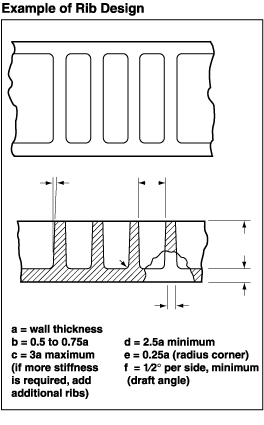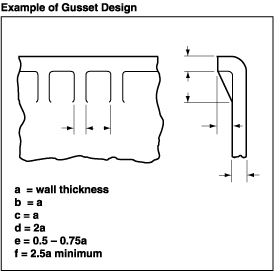
When designing ribs and gussets, it is important to follow the proportional thickness guidelines shown in the Example of Rib Design illustration and the Example of Gusset Design illustration. If the rib or gusset is too thick in relationship to the part wall, sinks, voids, warpage, weld lines (all resulting in high amounts of molded-in stress), longer cycle times can be expected.
The location of ribs and gussets also can affect mold design for the part. Keep gate location in mind when designing ribs or gussets. For more information, see Gates. Ribs well-positioned in the line of flow, as well as gussets, can improve part filling by acting as internal runners. Poorly placed or ill-designed ribs and gussets can cause poor filling of the mold and can result in burn marks on the finished part. These problems generally occur in isolated ribs or gussets where entrapment of air becomes a venting problem.
Note: It is further recommended that the rib thickness at the intersection of the nominal wall not exceed one-half of the nominal wall in HIGHLY COSMETIC areas. For example, in the Example of Rib Design illustration, the dimension of the rib at the intersection of the nominal wall should not exceed one-half of the nominal wall.
Experience shows that violation of this rule significantly increases the risk of rib read-through (localized gloss gradient difference).

